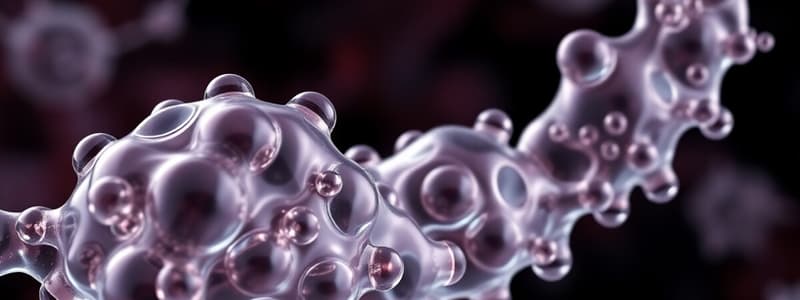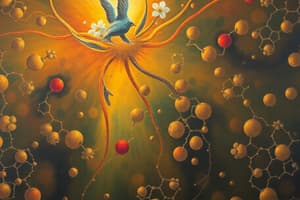Podcast
Questions and Answers
Which of the following statements about lipids is true?
Which of the following statements about lipids is true?
- Lipids are soluble in water.
- Lipids cannot self-assemble in water.
- Lipids are a homogenous group related only to saturated fatty acids.
- Lipids can self-assemble due to the hydrophobic effect. (correct)
What is the primary role of lipids in organisms?
What is the primary role of lipids in organisms?
- They primarily contribute to the immune response.
- They serve as the main energy reserve of the organism. (correct)
- They are the main structural component of amino acids.
- They are primarily involved in muscle contraction.
Which of the following best describes simple lipids?
Which of the following best describes simple lipids?
- They are complex structures containing multiple fatty acids.
- They are esters of fatty acids with various alcohols. (correct)
- They are only found as solid fats in living organisms.
- They do not include any alcohol component in their structure.
Which of the following is NOT a characteristic of complex lipids?
Which of the following is NOT a characteristic of complex lipids?
What distinguishes glycolipids from other lipids?
What distinguishes glycolipids from other lipids?
What type of fatty acids are characterized by having double bonds in their structure?
What type of fatty acids are characterized by having double bonds in their structure?
Which of the following fatty acids is recognized as a crucial precursor for inflammatory mediators?
Which of the following fatty acids is recognized as a crucial precursor for inflammatory mediators?
How do unsaturated fatty acids affect the melting point compared to saturated fatty acids?
How do unsaturated fatty acids affect the melting point compared to saturated fatty acids?
What is a common effect of trans fatty acids on human health?
What is a common effect of trans fatty acids on human health?
What is the primary reason for the low melting points of unsaturated fatty acids?
What is the primary reason for the low melting points of unsaturated fatty acids?
What role do triacylglycerols primarily serve in the body?
What role do triacylglycerols primarily serve in the body?
What is the composition of a triacylglycerol?
What is the composition of a triacylglycerol?
What is a key function of lecithins in biological systems?
What is a key function of lecithins in biological systems?
Which of the following is NOT a characteristic of triacylglycerols?
Which of the following is NOT a characteristic of triacylglycerols?
What happens in the absence of lecithins in neonates?
What happens in the absence of lecithins in neonates?
What condition results from a lack of Vitamin D leading to skeletal issues?
What condition results from a lack of Vitamin D leading to skeletal issues?
Which of the following is a role of Vitamin A derivatives in the body?
Which of the following is a role of Vitamin A derivatives in the body?
Which drug is associated with treating Respiratory Distress Syndrome in neonates?
Which drug is associated with treating Respiratory Distress Syndrome in neonates?
What is a possible symptom of rickets due to Vitamin D deficiency?
What is a possible symptom of rickets due to Vitamin D deficiency?
Which vitamin is specifically linked to maintaining epithelial tissue health?
Which vitamin is specifically linked to maintaining epithelial tissue health?
What is the major component in vertebrate heart tissue lipids?
What is the major component in vertebrate heart tissue lipids?
Which substance stimulates platelet aggregation and is released from basophils?
Which substance stimulates platelet aggregation and is released from basophils?
What determines an individual's ABO blood type?
What determines an individual's ABO blood type?
What is a key function of cholesterol in the body?
What is a key function of cholesterol in the body?
What do phospholipases specifically degrade?
What do phospholipases specifically degrade?
What role do diacylglycerol (DAG) play in cells?
What role do diacylglycerol (DAG) play in cells?
Which secondary messenger is involved in calcium release from the endoplasmic reticulum?
Which secondary messenger is involved in calcium release from the endoplasmic reticulum?
Which of the following statements about eicosanoids is true?
Which of the following statements about eicosanoids is true?
What distinguishes steroid hormones from cholesterol?
What distinguishes steroid hormones from cholesterol?
Which factor is crucial for vitamin D3 production in the body?
Which factor is crucial for vitamin D3 production in the body?
What is the function of the phosphatidylinositol 4,5-bisphosphate (PIP2)?
What is the function of the phosphatidylinositol 4,5-bisphosphate (PIP2)?
Which type of lipids are primarily involved in cell membrane structure in eukaryotes?
Which type of lipids are primarily involved in cell membrane structure in eukaryotes?
What process does Activation of Protein Kinase C primarily involve?
What process does Activation of Protein Kinase C primarily involve?
Which lipids are thought to play a significant role in allergic responses?
Which lipids are thought to play a significant role in allergic responses?
Flashcards are hidden until you start studying
Study Notes
Lipids: Introduction
- Lipids are a heterogeneous group of molecules related to fatty acids, which are long chains of carbons linked together with a carboxylic acid group at one end.
- Lipids are insoluble in water but soluble in non-polar solvents. They can form structures like micelles and bilayers in water due to their hydrophobic nature.
Lipid Roles in Organisms
- Lipids are a high-energy source in diets, and they provide essential fatty acids like linolenic and linoleic acid.
- Lipids are the organism's main energy reserve.
- They function as insulating materials, for example, in adipose tissue and nerve cells.
- Lipids are involved in cellular membranes, transport, and signaling, for example, as lipoproteins.
Lipid Classification
- Simple lipids: esters of fatty acids with alcohols.
- Fats: esters of fatty acids with glycerol. These can either be liquid (oils) or solid depending on their fatty acid composition and molecular weight.
- Waxes: esters of fatty acids with high molecular weight alcohols.
- Complex lipids: esters of fatty acids containing other groups besides an alcohol and fatty acid.
- Phospholipids:
- Glycerophospholipids: glycerol is the alcohol.
- Sphingophospholipids: sphingosine is the alcohol.
- Glycolipids: a combination of a fatty acid, sphingosine, and carbohydrate.
- Lipoproteins: a combination of lipids and proteins.
- Phospholipids:
- Precursor and derived lipids: fatty acids, steroids, terpenes, and glycerol.
Fatty Acids
- Fatty acids are long-chain carboxylic acids. Naturally occurring fatty acids usually have an even number of carbon atoms due to their biosynthetic origin.
- Fatty acids can either be saturated or unsaturated. The degree of unsaturation affects their physical and chemical properties.
- Essential fatty acids are precursors of inflammatory mediators.
Unsaturated Fatty Acids
- Mono- and polyunsaturated fatty acids (PUFAs) exist.
- Different numbering conventions are used in chemistry and physiology to describe the location of double bonds.
- Eicosanoic fatty acids, particularly arachidonic acid, are precursors of prostaglandins, leukotrienes, thromboxanes, and prostacyclins. These lipids play essential roles in inflammation and pain.
- Due to the presence of double bonds, unsaturated fatty acids have lower melting points, which is important for membrane fluidity.
- Unsaturated fatty acids can undergo oxidation, causing rancidity and potential tissue damage. They have been implicated in cancer and inflammation.
- Trans fatty acids, rare in nature, can elevate plasma cholesterol levels.
Triacylglycerols
- Triacylglycerols are triesters of glycerol with fatty acids.
- They can have identical or different fatty acid chains.
- They are non-polar, water insoluble, and have lower density than water.
- They serve as excellent thermal and electrical insulators.
Waxes
- Waxes have many uses, including energy storage and water repellency. They have diverse pharmaceutical and cosmetic applications.
Glycerophospholipids
- These are the main components of cellular membranes.
Lecithins
- Lecithins, such as dipalmitoyl phosphatidylcholine (DPPC), are surfactants that reduce surface tension. They are critical for neonates as their absence causes Respiratory Distress Syndrome (RDS).
Lipids with Ether Linkages
- Present in vertebrate heart tissue, these lipids are released from leukocytes and can stimulate platelet aggregation and serotonin release.
- They are important for inflammation and allergic response.
Sphingolipids
- Sphingolipids are a class of lipids with a sphingosine backbone.
Glycosphingolipids
- Glycosphingolipids determine ABO blood types.
Enzymatic Degradation of Phospholipids
- Phospholipases are enzymes that break down phospholipids, exhibiting specificity for their substrates.
Sterols
- Sterols are structural lipids found in eukaryotic cell membranes. These lipids contain a characteristic steroid nucleus.
- Cholesterol is a type of sterol.
- Cholesterol is excreted as bile acids.
Lipids: Signaling Role
- Specialized lipids play important roles in signaling pathways. For example, phosphatidylinositol 4,5-bisphosphate (PIP2) is broken down into inositol 1,4,5-triphosphate (IP3) and diacylglycerol (DAG), which act as secondary messengers.
- IP3 increases intracellular calcium levels, while DAG activates protein kinase C.
Eicosanoids
- These are paracrine hormones produced locally and affect nearby cells.
- Eicosanoids are very lipophilic.
Steroid Hormones
- Steroid hormones are oxidized derivatives of sterols.
- They lack the alkyl chain present in cholesterol and are more polar. They travel in the blood from production site to target tissues, where they stimulate specific nuclear receptors.
- Examples of steroid hormones include sex hormones and hormones produced by the adrenal cortex.
- Synthetic steroids are often used for their anti-inflammatory activities.
Vitamin D3 Production and Metabolism
- Vitamin D3 is not synthesized in the body and must be obtained through diet.
- The active form of vitamin D3 is calcitriol.
- Deficiency in vitamin D3 leads to rickets, causing skeletal deformities, delayed growth, increased fracture risk, dental problems, and muscle weakness.
Isoprenoids: Vitamin A1, Precursors, and Derivatives
- Vitamin A1 is found in milk and fish liver oil.
- It is a precursor for visual pigments and the hormone involved in epithelial tissue development.
Other Biologically Active Isoprenoid Compounds
- Isoprenoids include other biologically active compounds like vitamin E (tocopherol), which is an antioxidant.
Drugs and Diseases
- Lipids are involved in several diseases, including Respiratory Distress Syndrome (RDS), thrombosis, inflammation, asthma, and rickets.
- Drugs and supplements related to lipids include synthetic DPPC, linoleic and linolenic acids, prednisone, prednisolone, vitamins A, D (calcitriol), E, K1, coenzyme Q, and warfarin.
Studying That Suits You
Use AI to generate personalized quizzes and flashcards to suit your learning preferences.




